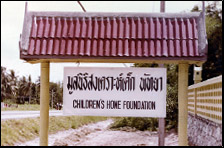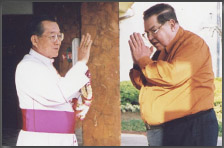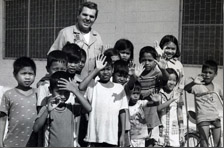History
 In 1972, Rev. Fr. Raymond Allyn Brennan, a Redemptorist priest, was requested to go to help work at St. Nikolaus Church, Pattaya, temporarily, and one morning when he opened the church door he saw a newborn child left at the stairway front. Not knowing what to do, he took care of the child, asking his friends about “how to give milk and how to change the diaper”. News about the fostering of the child spread, resulting in more children being brought to give to him, most of whom were fruits of the presence of the U.S. military base at Sattahip.
In 1972, Rev. Fr. Raymond Allyn Brennan, a Redemptorist priest, was requested to go to help work at St. Nikolaus Church, Pattaya, temporarily, and one morning when he opened the church door he saw a newborn child left at the stairway front. Not knowing what to do, he took care of the child, asking his friends about “how to give milk and how to change the diaper”. News about the fostering of the child spread, resulting in more children being brought to give to him, most of whom were fruits of the presence of the U.S. military base at Sattahip.
During the Vietnam War, Pattaya became a favorite place of the American servicemen who came for recreations, so there were a large number of abandoned children. A military officer and Father Ray consulted each other on how to find ways and means of aid. Eventually, both of them went to see Bishop Thienchai Samanchit, the Bishop of the Chanthaburi Diocese at the Bishop’s House, Siracha, informing him that the American veterans intended to build a home for orphans at Pattaya and present it to the Diocese, of which Father Ray Brennan volunteered to be the manager, since it was found that many orphans were born of American servicemen in the days of their presence at U-Tapao U.S. base during the Vietnam War.
Bishop Thienchai answered the American military officer, saying, “It is not difficult for you to build a home for orphans and then wash your hand and go home, while it is not known where the Diocese will get money from to feed those orphans”. So he asked for an initial capital of Baht 500,000 (Baht Five Hundred Thousand Only). The American military officer nodded approval but asked for 5 years’ time.
 Thereafter, Bishop Thienchai took counsel with his advisors as to whether or not to accept the Pattaya Orphanage. Some of the advisors raised an objection, saying that the orphanage should not be constructed, because it was like supporting the easy existence of a growing number of orphans. Some of them said that even if the orphanage did not exist, there were already a large number of orphans. Eventually, the Diocese passed a resolution accepting the Pattaya Orphanage to belong to the Diocese. Father Ray and the American servicemen constructed the orphanage on a land (of approximately 7.6 acres) of the Diocese, of which the Diocese prescribed 2 acres on the rear side for use as the compound of the orphanage. Brother Connie of the Redemptorist Order was the construction drawing maker, while the Diocese reserved 5.6 acres of the land on the road front side.
Thereafter, Bishop Thienchai took counsel with his advisors as to whether or not to accept the Pattaya Orphanage. Some of the advisors raised an objection, saying that the orphanage should not be constructed, because it was like supporting the easy existence of a growing number of orphans. Some of them said that even if the orphanage did not exist, there were already a large number of orphans. Eventually, the Diocese passed a resolution accepting the Pattaya Orphanage to belong to the Diocese. Father Ray and the American servicemen constructed the orphanage on a land (of approximately 7.6 acres) of the Diocese, of which the Diocese prescribed 2 acres on the rear side for use as the compound of the orphanage. Brother Connie of the Redemptorist Order was the construction drawing maker, while the Diocese reserved 5.6 acres of the land on the road front side.
In the initial period Father Ray contacted the Sisters (Soeurs) of the Order of St. Paul de Chartre to come to be housekeepers looking after the children.
…On October 24, 1978, the Governor of Chonburi Province issued the Pattaya Orphanage establishment license.
…On March 1, 1979, Bishop Thienchai contacted the Sisters of the Order of Lovers of the Cross of Chanthaburi to come to perform the duties in place to date.
…On January 9, 1981, the National Cultural Commission Secretary General issued the Pattaya Orphanage organization license.
…On March 27, 1981, permission was received to be a child welfare organization operating for the adoption of both Thai and foreign children.
 When the 5-year schedule fell due, the American veterans collected the amount of Baht 500,000 to give to the Pattaya Orphanage as they had promised.
When the 5-year schedule fell due, the American veterans collected the amount of Baht 500,000 to give to the Pattaya Orphanage as they had promised.
In 1995, a 3-storey building was constructed as the lodging or boys and mentors.
In 1999, a 5-storey building was constructed as a learning place of Sot Pattana (Audio Development) Kindergarten for dumb and deaf children and as the lodging of both male and female small orphans.
In 2001, a 2-storey building was constructed, the lower floor being the dining hall, the upper floor being the multi-purpose meeting hall, the last piece of construction for the Pattaya Orphanage.
In 2003, after Father Ray’s death, Father Banchong Chaiyara and Father Larry Patin subsequently managed the work of the orphanage.
In 2006, the first building was overhauled.
It had been until January 1, 2008 when the Chanthaburi Diocese assigned Father Michael Weera Phangrak to be the Pattaya Orphanage Director and Father Kritsada Sukkaphat, the Deputy Director.
Currently the Pattaya Orphanage takes care of approximately 160 orphans, ranging from newborn to studying at the university level.
Objectives
1.To provide help to orphans by accepting to bring up poor orphans and providing lodging, food and education services without limitation in race and religion;
2.To provide families with readiness who want to adopt orphans under the child adoption law;
3.To provide education to orphans according the their intelligence in as much as their ability to learn and to provide them with employment when they finish their education;
4.To cooperate with other charity organizations that work about children for public interest.
Frequently Asked Questions
Question: How can children come to be in the care of the Pattaya Orphanage?
Answer: Most children are brought to give to the foundation by their mothers for several reasons. Some children come from poverty-stricken families, but what makes the majority of reasons is the problem of broken families, parents separating from each other. The Orphanage takes such children in order to help promote them for full development, being ready to develop themselves, to live a normal, happy life.
Question: Is it possible to adopt every child?
Answer: No, not every child can be adopted. It depends on the readiness of the child’s and the parents’ personal evidences to adopt a child. In case of abandoned children, it is rather difficult to follow up to get the evidences. Nevertheless, although they cannot be adopted, they can be taken care of to have prestige, to have a good future, to be able to adjust themselves happily to the society.
Question: What procedure is there for applying to be a patron of a child from the Orphanage?
Answer: You have to submit an application for adopting a child through the agent in your country who has lawfully received a license from the Child Adoption Administration Center. The officers of the organization will give you information on the detailed procedure for you to prepare the required documents.
Question: Are the children HIV/AID infected or not?
Answer: No. We regularly check every baby for the purpose of detecting HIV. Although Thailand has a high rate of HIV/AID infection, a very small number of children sent to us are infected, and if we discover that a child is HIV infected, we would send him or her to another organization that is specialized in taking care of HIV/AID infected persons.
Question: Up to what level do the children at this Orphanage have an opportunity to learn?
Answer: Every child has the opportunity of receiving every level of education according to his or her intelligence. It is the Orphanage’s policy to let the children study up to the bachelor’s degree level.
Question: For how long can the children stay at the Orphanage?
Answer: The children are in the care of the Orphanage until they finish their education, have a job to do and are ready to seek after life experiences in order to help themselves, and when they run into problems, the Orphanage is willing to give advice and assistance from case to case. However, the relations between the children and the Orphanage remain unchanged.
Question: How can we provide assistance?
Answer: You can give assistance by a good number of means, e.g. make donations in check or cash, giving scholarships, providing powdered milk, buying articles to give or being sponsors treating the children to meals.
Health
With a qualified nurse working full time at the Orphanage, and weekly visits from a Consultant Paediatrician, our children are in pretty good health.
On arrival at the Orphanage, the nurse checks for any signs and symptoms of any health condition, and gives all babies a routine medical check, and all babies will be checked over by the Doctor on her visits.
As in many countries throughout the world, the Thai Ministry of Health advises that children should be immunized and vaccinated against childhood conditions such as diphtheria, tetanus, whooping cough, measles, Hib and polio. Our children receive all the necessary immunizations.
Education
We believe that education is one of the most important things that the children should receive, so we gradually instill in our children the perception of the importance of education from early childhood, providing learning and instruction in each group of children.
 Pre-kindergarten – Kindergarten Grades, the age of 3-6 years:
Pre-kindergarten – Kindergarten Grades, the age of 3-6 years:
We prepare readiness for children, arrange children to attend classes according to their age, make available teachers as mentors by following the kindergarten-level curriculum of learning and instruction. The children would receive development according to the process of learning and instruction, the purpose being to prepare them to go out into the outside society, to study jointly with other children in various schools
Primary Grades, the age of 7 years:
The orphanage sends the children to study in both government and private schools, where they would spend six more years’ time learning various subjects taught in those schools in the same manner as children all over the world, both reading, writing, Thai language, English language, mathematics, computer and social sciences.
Secondary Grades:
After finishing the primary education, the children must take an entrance test for further learning at the secondary level where they would continue studying for 3 or 6 more years, depending on what they want to do in the future. For example, if they choose to be car repairmen, they must attend school in the vocation line after finishing Secondary Grade 3; but if they wish to become teachers, or physicians or nurses, they must complete Secondary Grade 6 before choosing to study further at the university level subsequently.
University Level:
When our children have chosen it that they want to continue studying at the university level and they have successfully passed the entrance test and been admitted by the university, the orphanage will be responsible for all their expenses, both the school fee, the lodging and food charges, to the university of their choice. Many of our children meet with success, have a job to do and earn an income to support themselves.
During the period of school holidays, all of the children would receive instructional reinforcements in the subjects of computer, English language, music and cooking.
Facilities
The Pattaya Orphanage is a large complex, which has many buildings needed to house all our children. There is the main, original building which still houses the baby rooms, as well as a main TV room and recreation room. Other buildings include dormitories for the younger children, and small rooms for the older orphans.
The original dining room became too small to fit all our children in, so a new bigger hall was built in 2000, which allows all the children to eat together. Above the dining room is a large auditorium, and it is here that special events are held, events such as the King’s and Queen’s Birthday and Christmas (even though most of the children are Buddhists we still give them Christmas presents). We have also had a wedding reception in this hall when one of our orphans got married.
Baby room

At any one time we can have as many as fifty babies under the age of three in our baby rooms. This is where they sleep, eat and play, all under the watchful eye of the baby sitters, who treat all our babies as if they were their own children.
Apart from the baby sitters, there is a qualified paediatric nurse who is available on site 24 hours a day, and every Saturday the baby room is visited by an American trained Consultant paeditrician, who comes and checks on all our babies. We are very lucky, as this Doctor has been visiting every week for over 20 years and has never sent us a bill.


